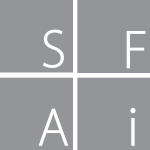Dear Friend of SFAI,
As this year comes to a close, I would like to share with you some of the values that underpin the Santa Fe Art Institute’s work and how we view ourselves as a learning organization. Our annual themes are not only a framework to engage with artists locally and from around the world, but an opportunity for SFAI to examine our role in the community and the arts, our daily practices, and the programming and operating decisions we make.
November is the last month of the Truth and Reconciliation residency. We have learned a tremendous amount since launching Truth & Reconciliation in September 2018, both from our Northern New Mexico community and the over 100 artists and creative practitioners that have participated in the thematic residency and our public programming over the last year.
One learning in particular I would like to share with you is land acknowledgement and what that means to us. SFAI has practiced land acknowledgement over the last three years, thanks to two Canadian First Nations and Métis artists in residence, Jason Baerg and Vanessa Dion-Fletcher. We acknowledge at our public events and on our website that O’ghe P’oghe—the original Tewa name for Santa Fe, which means White Shell, Water Place—is located on unceded territorial lands of the Tewa and Tanos people. We honor these people—past, present and future—as well as the many other Indigenous peoples who inhabited, held sacred, and stewarded this land.
Over the last year, we have learned a tremendous amount from local Indigenous leaders and community members, as well as the U.S. Department of Arts and Culture’s #HonortheLand project. We know that a simple statement, while powerful, is not enough. We must work to better engage with local and regional Indigenous communities, and to support their leadership and voices. This is why we hosted the Platform: ReMatriate event in October, celebrating and forefronting the voice and leadership of Indigenous women, and why there was a strong focus on Indigenous health and wellness at our Platform: Gender Equality and Wellness Fair in January. It is why the Story Maps Fellowship, specifically geared to local Indigenous, Black and artists of color, is now an integral aspect of our programming. It is why we are proud to have hosted artists and creative practitioners from 13 tribal nations during the Truth & Reconciliation theme. The work of Truth and Reconciliation is a deeply creative act and a constant learning, and we will continue to step into this work with humility.
So, as we head into Thanksgiving week, let’s all be conscious of what this national holiday truly reflects. For many of us, Thanksgiving has come to mean a beautiful meal with family or consumer hype (or perhaps both), and we may not even stop to consider the history of Thanksgiving amidst travel plans and meal preparations—not to mention the stress of that looming conversation about politics.
But for many of our country’s first peoples, Thanksgiving is not only celebrating a false history, but proves yet again how invisible they and their realities are to mainstream America. Did you know that there are over 565 federally recognized sovereign tribal nations? This is not even including the many more communities that are state-recognized or have not received U.S. government recognition. The Thanksgiving that celebrates Pilgrims and Native Americans breaking bread, inasmuch as it is a real story, is a story about only one such community, the Mashpee Wampanoag people, and I encourage you to read this New Yorker article about the true history of Thanksgiving and the Mashpee Wampanoag.
This holiday, please consider what you can personally do to acknowledge the true histories and contemporary realities of Native Americans. Check out this great map, showing Indigenous territories and languages around the world, and consider supporting amazing Indigenous-led organizations who are doing brilliant work, such as Tewa Women United, the Pueblo Action Alliance, Native Women Lead, Sovereign Bodies Institute, Utah Diné Bikéyah, and First Nations Community Health Source.
SFAI gives thanks to all of you, our SFAI community. In the coming year, SFAI will celebrate 35 years as an organization, and we will continue to share with you our gratitude and our ongoing learning from the annual themes and the brilliant artists and creative practitioners we support. We invite you to be part of our learning community and to continue supporting our work. Please consider SFAI in your year-end giving. Together, we can invest in community, culture, and place to reimagine a more equitable world.
Sincerely,
Jamie Blosser
Executive Director/ CEO

 © Santa Fe Art Institute / Santa Fe, New Mexico /
© Santa Fe Art Institute / Santa Fe, New Mexico /